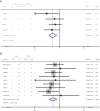Left-side vs. right-side hepatectomy for hilar cholangiocarcinoma: a meta-analysis
- PMID: 33838682
- PMCID: PMC8037893
- DOI: 10.1186/s12957-021-02213-6
Left-side vs. right-side hepatectomy for hilar cholangiocarcinoma: a meta-analysis
Abstract
Goals: We aim to draw a conclusion which type of hepatectomy could be the priority for hilar cholangiocarcinoma patients.
Background: Surgery is established as only potentially curative treatment for hilar cholangiocarcinoma. However, whether hepatectomy should be preferred to the left-side hepatectomy, which includes left hemihepatectomy, extended left hemihepatectomy, and left trisectionectomy, or right-side hepatectomy, which represents right hemihepatectomy, extended right hemihepatectomy, and right trisectionectomy, is debated. In this meta-analysis, we evaluated and compared the efficacy and safety of left-side hepatectomy and right-side hepatectomy in patients with hilar cholangiocarcinoma.
Study: We systematically retrieved the MEDLINE, PubMed, and Cochrane library and related bibliography up to February 2020. The primary outcome is overall survival, and the secondary outcome includes 1-, 3-, and 5-year survival rates, morbidity, mortality, R0 resection rate, and operation time. Based on heterogeneity, fixed-effects model or random-effects models were established through meta-analysis.
Results: Eleven studies (11 cohort studies, totally 1031 patients) were involved in this study. The overall survival of patients who underwent left-side hepatectomy was comparable to that of patients who underwent right-side hepatectomy (hazard ratio, 1.27 [95% confidence interval, 0.98-1.63]). And there was no significant difference observed in 1-year (relative risk, 1.01 [95% CI, 0.89-1.15]), 3-year (relative risk, 0.94 [95% confidence interval, 0.80-1.11]), and 5-year survival (relative risk, 0.82 [95% confidence interval, 0.67-1.01]) rates between the left-side hepatectomy group and the right-side hepatectomy group. Comparing with the right-side hepatectomy cluster, the hilar cholangiocarcinoma patients in the left-side hepatectomy cluster presented better overall postoperative morbidity (relative risk, 0.82 [95% confidence interval, 0.71-0.96]) and major postoperative morbidity (relative risk, 0.73 [95% confidence interval, 0.56-0.95]). The post-hepatectomy liver failure rate (relative risk, 0.22 [95% confidence interval, 0.09-0.56]) and procedure-related mortality (relative risk, 0.41 [95% confidence interval, 0.23-0.70]) in the left-side hepatectomy group were better than those of the right-side hepatectomy group. Besides, the R0 resection rate was similar between the left-side hepatectomy group and the right-side hepatectomy group (relative risk, 0.95 [95% confidence interval, 0.87-1.03]). And the operation time for the left-side hepatectomy was significantly longer than that for the right-side hepatectomy (mean difference, 38.68 [95% confidence interval, 7.41-69.95]).
Conclusion: Through meta-analysis, we explored the comparable long-term outcomes and better short-term outcomes in the left-side hepatectomy group as is compared to the right-side hepatectomy group of hilar cholangiocarcinoma patients. In this study, the evidence obtained might indicate that the choice of left-side hepatectomy or right-side hepatectomy depends on the site of hilar cholangiocarcinoma in every patient.
Keywords: Hilar cholangiocarcinoma; Left-side hepatectomy; Meta-analysis; Perihilar cholangiocarcinoma; Right-side hepatectomy.
Conflict of interest statement
All authors have completed the ICMJE uniform disclosure form. The authors declare that they have no competing interest.
Figures







References
Publication types
MeSH terms
Grants and funding
LinkOut - more resources
Full Text Sources
Other Literature Sources
Medical

